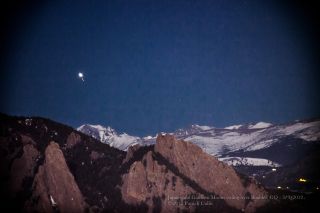
Jupiter and Venus streak through the sky above snowcapped Colorado peaks in a dazzling new skywatcher video.
The one-minute video, created by amateur astronomer Patrick Cullis with footage he shot last week, shows the two bright planets setting behind the iconic Flatiron Mountains near the city of Boulder.
"I'm especially happy with it because you can clearly see Jupiter's moons setting in formation with the giant gas planet," Cullis told SPACE.com in an email. The bulk of the footage was captured with two cameras and a telescope on March 8 and 9, he added.
After creeping closer and closer together for months, Venus and Jupiter are now putting on a dynamic double show for skywatchers. The two planets — the brightest in the night sky — are now so close together that you can block out both of them with a few fingers held at arm's length.
The dual tango peaked Tuesday (March 13), when the two planets came within just 3 degrees of each other in what's known as a planetary conjunction. (Your clenched fist held at arm's length measures about 10 degrees.)
Somewhat confusingly, Jupiter and Venus also technically come into conjunction on Thursday (March 15), when they line up in another set of celestial coordinates. But they'll be slightly farther apart on that date than on Tuesday.
Venus-Jupiter conjunctions happen just once every 13 months or so, and this one should be more spectacular than most, experts say. At mid-northern latitudes on Tuesday, the pair should be visible over the western horizon for several hours, with Venus blazing considerably more brightly than its planetary partner.
Get the Space.com Newsletter
Breaking space news, the latest updates on rocket launches, skywatching events and more!
Though Jupiter and Venus appear close together in the night sky these days, in reality they're nowhere near each other. Venus orbits the sun at a distance of roughly 67 million miles (108 million kilometers), while Jupiter is found about 484 million miles (779 million km) from our star.
For comparison, Earth zips around the sun from about 93 million miles (150 million km) away. The orbits of Venus and Jupiter are separated by Earth, Mars and the main asteroid belt.
If you snap an amazing photo of Venus and Jupiter, or any other skywatching target, and would like to share it for a possible story or image gallery, please contact SPACE.com senior writer Mike Wall at mwall@space.com.
You can follow SPACE.com senior writer Mike Wall on Twitter: @michaeldwall. Follow SPACE.com for the latest in space science and exploration news on Twitter @Spacedotcomand on Facebook.
Join our Space Forums to keep talking space on the latest missions, night sky and more! And if you have a news tip, correction or comment, let us know at: community@space.com.

Michael Wall is a Senior Space Writer with Space.com and joined the team in 2010. He primarily covers exoplanets, spaceflight and military space, but has been known to dabble in the space art beat. His book about the search for alien life, "Out There," was published on Nov. 13, 2018. Before becoming a science writer, Michael worked as a herpetologist and wildlife biologist. He has a Ph.D. in evolutionary biology from the University of Sydney, Australia, a bachelor's degree from the University of Arizona, and a graduate certificate in science writing from the University of California, Santa Cruz. To find out what his latest project is, you can follow Michael on Twitter.
